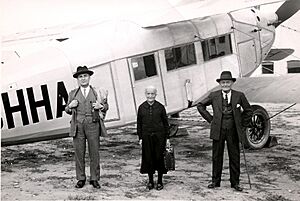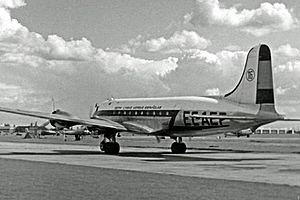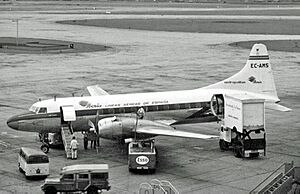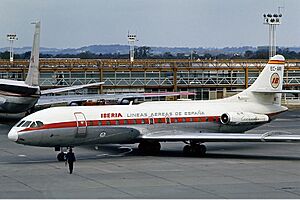History of Iberia (airline) facts for kids
Iberia Líneas Aéreas de España, S.A. (which means Iberia Airlines of Spain in English), usually just called Iberia, is the biggest airline in Spain. Its main base is in Madrid. Iberia helps people travel all over the world, connecting Spain with many other countries, especially in Europe and Latin America.
Contents
The Story of Iberia: How it Started
After World War I, airplanes got much better and could fly faster and farther. This made it easier for businesses to connect across countries. Germany, for example, had many businesses in Africa and South America but needed better ways to reach them than just ships.
Because of rules from the Treaty of Versailles (a peace treaty after World War I), German planes couldn't fly over France. So, people in Spain looked into starting an airline connection between Germany and Spain. On December 9, 1927, the German government and the Spanish government agreed to start an air service between their countries.
Early Flights (1927–1929)
The company Iberia, Compañía Aérea de Transportes was officially created on June 28, 1927. It got money from a Spanish financier and a German airline called Deutsche Luft Hansa. The company was allowed to offer daily flights (except Sundays) between Madrid and Barcelona. They bought three Rohrbach Roland planes from Deutsche Luft Hansa.
Flights began on December 14, 1927. The first flights were planned to happen during a special event in Madrid. The opening ceremony at Cuatro Vientos Airport was attended by King Alfonso XIII. The first flight from Madrid left on time and arrived in Barcelona 3½ hours later. However, the flight from Barcelona to Madrid had to stop in Almazán, Soria because of snow, causing a delay.
Within a year, the Spanish government asked Iberia to carry mail between Madrid and Barcelona. Deutsche Luft Hansa, which had invested in Iberia, also got a good deal: it was allowed to start regular flights between Germany and Spain. In July 1928, Iberia added a twin-engined Dornier Wal seaplane to its fleet. This plane was used for a new route between Cádiz and the Canary Islands. This was a test to see if a mail route to South America could work.
Changes and New Names (1929–1939)
During the time when Miguel Primo de Rivera was in charge of Spain, it was decided that all Spanish aviation companies should join together and be controlled by the government. This happened in early 1928. Because of this, Iberia joined with other airlines to form a new company called Compañía de Líneas Aéreas Subvencionadas S.A. (C.L.A.S.S.A.).
Iberia stopped its own flights on May 29, 1929, but the name "Iberia" was kept registered. Out of all the airlines that joined CLASSA, Iberia was the only name that would be used again later.
After the proclamation of the Second Spanish Republic in 1931, a new airline called LAPE (Líneas Aéreas Postales Españolas) took over from CLASSA. LAPE started flying in April 1932.
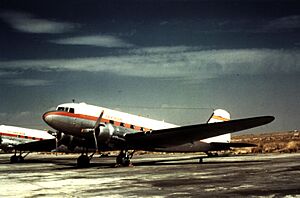
LAPE continued to fly even during the Spanish Civil War, mainly on its Madrid - Barcelona route. However, many of its planes were taken by the Spanish Republican Air Force to be used for military transport.
Since the name "Iberia" was still registered, it was used again when airline flights started up in 1937 in the areas controlled by the other side during the Spanish Civil War. In 1939, after the war ended, the planes that belonged to LAPE were repainted with the Iberia airline colors.
After World War II (1939–1944)
When Iberia fully started flying again after World War II, it became an airline mainly for flights within Spain. It also won the right to fly many international routes, like the one between Madrid and Lisbon.

The Spanish government owned 51% of the new Iberia, and private investors owned 49%. The company still had strong connections with the German airline Lufthansa. During World War II, this made it hard for Iberia to get fuel and spare parts for its planes. Also, the Allied Powers (like the US and UK) refused to work with Iberia until it stopped its connections with Nazi Germany.
Becoming a National Airline (1944–2001)
Iberia became a national airline on September 30, 1944, meaning it was owned by the Spanish government. In 1946, Iberia became the first airline to fly between Europe and South America after World War II, using the Douglas DC-4 on routes to Montevideo and Buenos Aires. This was a very popular route because many families had been separated by the Civil War.
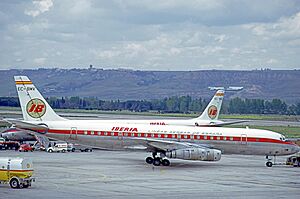
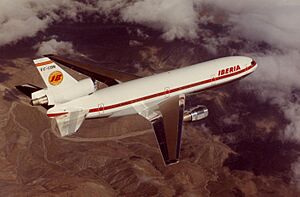
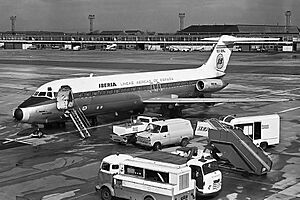
In 1953, it became easier for US visitors to travel to Spain, which led to new flights between Spain and the United States the next year. Iberia bought Lockheed Super Constellation planes for these long flights to North and South America starting in 1954.
From 1961, Iberia started using Douglas DC-8 jet planes for long-distance flights. The busiest route was Madrid to Buenos Aires. In the early 1970s, the company bought Douglas DC-9s and Boeing 747s as it added new routes to places like Central America, Warsaw, Athens, and Istanbul.
In 1974, Iberia started Europe's first "walk-on" shuttle service, connecting Madrid and Barcelona. That year, they also created Serviberia, a phone information service, which was like today's call centers. They also introduced "Red Jackets," uniformed staff on the ground to help customers.
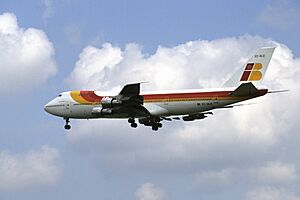
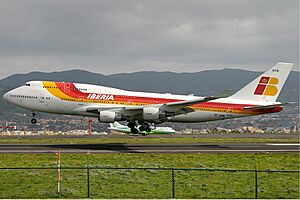

By its 50th anniversary in 1977, Iberia carried over 10 million passengers in one year for the first time. In the late 1980s and early 1990s, Iberia updated its fleet with newer planes like the McDonnell Douglas MD-87, Airbus A320, and Airbus A340. They also bought some Boeing 757s.
Around this time, Iberia started buying parts of other airlines in Spain and Latin America, like Aerolíneas Argentinas and Viasa. In 1991, Iberia created Europe's first international airline frequent-flyer program, called Iberia Plus. In 1996, the airline launched its website, www.iberia.com. In 1998, the company ordered 76 planes from Airbus, which was a very large order. This marked Iberia's move from mainly using Boeing planes to using Airbus planes.
By the late 1990s, the Spanish government began to sell parts of Iberia to private companies. In December 1999, Iberia became partly private. Shares were given to shareholders, and 9% was bought by British Airways.
Becoming a Private Company (2001–2009)
Iberia is now a large international travel group that flies to about 100 airports in 40 countries. It employs more than 26,000 people.
In 1992, Iberia celebrated its 75th anniversary, making it one of the oldest airlines in the world. Over those 75 years, almost 500 million people flew with Iberia. This made the company one of the five largest European airlines, especially important for flights connecting Spain with Europe and Latin America.
The Iberia Group also includes the Iberia Regional/Air Nostrum airline. Besides flying passengers and cargo, Iberia does many other things. These include maintaining aircraft, handling services at airports, IT systems, providing food on flights, and offering holiday packages.
Iberia Group airlines fly to 97 places in 40 countries. By working with other airlines, they offer flights to another 60 places in 25 countries. With nearly 200 planes, they make about 1,000 flights every day. In 2002, Iberia carried 28 million passengers and 210,000 tons of cargo.
Iberia also repairs and maintains planes for its own fleet and for 48 other companies. Iberia is the main company that provides ground handling services (like baggage and plane preparation) at all Spanish airports.
Iberia was one of the founding partners of Amadeus CRS, a computer system for booking airline tickets. It also works as a tour operator through its Viva Tours and Tiempo Libre groups, and helps with package delivery services through Cacesa.
Iberia is partners with American Airlines and British Airways. On September 1, 2019, it joined the Oneworld alliance, which is a group of airlines that work together.
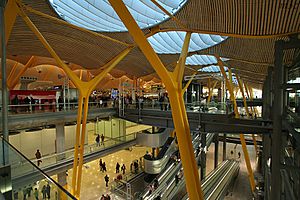
In July 2024, Iberia announced it would move its main hub for Latin American flights from Miami, Florida, to San Pedro Sula, Honduras. Iberia also plans to increase its flights to Puerto Rico to connect San Juan with cities in Central America.
In 2005, Iberia introduced its new Business Plus Class on its Airbus A340 planes.
On February 5, 1990, the new Terminal 4 at Madrid Barajas Airport was given to Iberia and the Oneworld alliance members. This allowed Iberia to grow. Iberia alone is responsible for about 60% of all flights at Madrid Barajas. In 2005, Iberia and its regional airline Air Nostrum carried over 21 million passengers to and from Madrid Barajas alone.
Iberia also partly owns a low-cost carrier airline called Clickair, which started in November 2006.
Joining Forces with British Airways (2010)
On November 12, 2009, Iberia Airlines announced that it had agreed to a plan to merge with British Airways. This merger would create the world's third-largest airline based on how much money they make. On April 25, 2010, British Airways and Iberia confirmed their merger, forming the International Airlines Group. Even though they merged, each airline still flies under its own name. The International Airlines Group has its main office in London and a registered office in Madrid. It mostly operates from its two main hubs: London Heathrow Airport and Adolfo Suárez Madrid–Barajas Airport.
Safety and Incidents
Like all airlines, Iberia has had some incidents and accidents over its long history. Airlines learn from these events to make flying safer for everyone. For example, in 1939, two of Iberia's planes crashed due to bad weather or being mistakenly shot down. In 1948, a plane crashed in bad weather, and in 1957, an engine fire caused a crash.
Later, in 1965, a plane crashed into the sea near Tangiers. In 1973, an Iberia plane was involved in a mid-air collision over France, and another plane overran the runway in Boston. In 1983, an Iberia plane collided with another plane on the runway at Madrid Airport during dense fog. In 1985, a plane crashed after hitting a television antenna while landing in Bilbao.
More recently, in 1996, an Iberia flight was hijacked, but no one was hurt. In 2007, an Iberia Airbus A340-600 was badly damaged after sliding off the runway in Ecuador, but again, no injuries were reported. These events, though serious, have helped the airline industry improve safety standards over the years.


